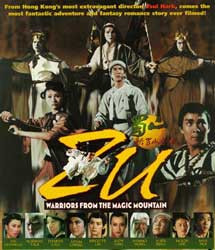 Nominally set during the time of 5th Century civil wars, the majority of Zu: Warriors from the Magic Mountain (Suk San: Sun suk san geen hap, 1983) is set nowhere & nowhen taking place mostly on & inside the titular mountain. Therein a struggle between Cartoons & the Gods over good & evil is played out with the fate of humankind the prize.
Nominally set during the time of 5th Century civil wars, the majority of Zu: Warriors from the Magic Mountain (Suk San: Sun suk san geen hap, 1983) is set nowhere & nowhen taking place mostly on & inside the titular mountain. Therein a struggle between Cartoons & the Gods over good & evil is played out with the fate of humankind the prize.
Loosely based on a 1920s newspaper serial by Li Shoumin, if the film adaptation is approached as a cartoon with some live actors worked into the design, & assumed to be aimed at eight or nine year olds, the goofy camp ridiculousness of Zu might be tolerable.
I tried to prepare my mind before entering the film, to be appreciative of a campfest. But even on its own level this film is a stinker, though inexplicably popular in its day. How anyone could ever have been impressed by badly animated light shows emanating from poorly choreographed kung fu fairies-in-flight is beyond me.
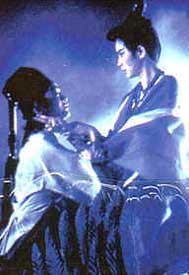 While the primitive FX have been compared to Tron & Star Wars, a better comparison would be Saturday morning Power Rangers. The bad animation makes it a bad cartoon, but aren't the reason the film fails. Even if it had been a better drawn cartoon it could never have been a good story. While the primitive FX have been compared to Tron & Star Wars, a better comparison would be Saturday morning Power Rangers. The bad animation makes it a bad cartoon, but aren't the reason the film fails. Even if it had been a better drawn cartoon it could never have been a good story.
But popular it was even so. Its impact on kung fu cinema is still being felt in childish & badlyk planned sword & sorcery films that try to fool the viewer with speed & color into not noticing there are no characters or story of merit.
Thereby today, instead of actors having to know how to move with physical grace with something approximating martial skill, they just have to pose in front of a blue-screen & pretend they're flying, or wait for the CGI artists to make them do something. Death rays will be added to their motionless palms, & we'll all go oo & ah, rip me off again.
None of this is any benefit to wuxia as a film genre, & the resultant conventionality of "anything-goes imagination" is about as far away from imaginative as films can get. But clearly there's a big audience out there that disagrees with me, or Tsui Hark couldn't possibly have had the detrimental influence he has had.
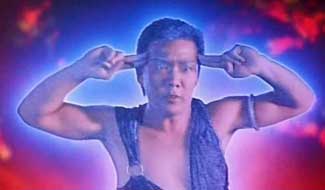 Perennially likeable Sammo Hung plays two roles, as the nice Warrior of the East dressed all in red (you'll see him in a fisticuff scene at the very end with director Tsui Hark), & as Long Brows, the Zu Mountain priest-divinity who fights against rocks with his long eyebrows.
Perennially likeable Sammo Hung plays two roles, as the nice Warrior of the East dressed all in red (you'll see him in a fisticuff scene at the very end with director Tsui Hark), & as Long Brows, the Zu Mountain priest-divinity who fights against rocks with his long eyebrows.
Many years later when a second Zu film was released, the old cast would be jettisoned, but Sammo as Long Brows would reprise this role. That his moronic character is a stand-out as memorable & fun is as much an indictment against the film as anything
I watched the Hong Kong release version in Chinese with English subtitles, widescreen. Unfortunately the primary American release is dubbed only. On the Hong Kong disc there was an alternate English language dubbing track & I listened to that for a bout ten minutes.
Generally dubbing horrifies me & part of the delight of such films is the sound of the original language. But this story was so awful, & so restricted to lame visuals, that it really sounded no worse in English than in Chinese, though it changes the tone & attitude of the original from one bad thing to an entirely different bad thing, so I still preferred the Chinese since I didn't want to blame Tsui Hark for faults that belonged with the dubbing team being fast & loose with the meaning of the action.
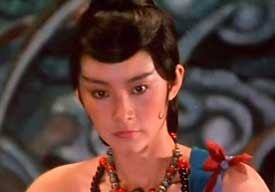 Fleeing a battlefield of three color-coded armies (Blue, Green, & Yellow), a human soldier (Biao Yuen) tumbles off a cliff & finds his way into a haunted cavern-temple. He must fight against dark supernatural powers beyond his ken (mainly a scarecrow with two small lightbulbs for eyes).
Fleeing a battlefield of three color-coded armies (Blue, Green, & Yellow), a human soldier (Biao Yuen) tumbles off a cliff & finds his way into a haunted cavern-temple. He must fight against dark supernatural powers beyond his ken (mainly a scarecrow with two small lightbulbs for eyes).
He's saved by a white-clad warrior-scholar fairy-divinity (Adam Cheng). Mistaking him for a mortal martial hero, our AWOL soldier begs to become his disciple.
Though the answer is no way no how, he's nevertheless drawn into the Zu Mountain battle of good dieties vs dark powers. Also along to help & hinder are a couple of Zen buddhist fairy-monks (Damian Lau & Mang Hoi). These primary characters have less charisma than a greasy-tailed dog.
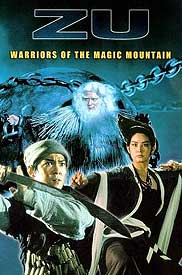 Floating on a cloud is a temple-fort ruled by martial fairy-maidens, their fearless leader called only Countess, played by Brigitte Lin. When the good knight-scholar becomes fouled by evil he cannot control himself from menacing the fairy maidens & what time is it kids? Flying kung fu fairy time! Floating on a cloud is a temple-fort ruled by martial fairy-maidens, their fearless leader called only Countess, played by Brigitte Lin. When the good knight-scholar becomes fouled by evil he cannot control himself from menacing the fairy maidens & what time is it kids? Flying kung fu fairy time!
When it looks like evil will win, the chief fairy maiden turns the whole fort into a block of ice, but poison-bad scholar-knight breaks free so that only the good fairy girls are frozen.
One of the fairy-girls who escapes is played by Moon Lee, doing very little beyond swinging on wires in what was her first martial role. She joins our mortal hero & one of the fairy monks in the continuing battle against the forces of the nasty-poos.
A whole series of encounters with badly animated evil, the ultimate evil being the Blood Monster which looks like an upright sea cucumber. Curiously there is no villain proper; the big dumb looking sea cucumber is the primary villain & doesn't do squat.
The only way to save the day is to find the Twin Swords on a penis-shaped mountain point & to have two men with a single mind bring them together after flying around a long time. The cartoon action is truly nonstop, leaving no room for even the slightest excuse for a story.
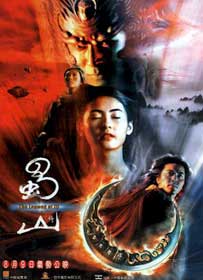 Tsui Hark has been responsible for some of the worst fantasy films ever made anywhere in the world. Yet the public has loved some of his crappy movies, & even Zu: Warriors from the Magic Mountain influenced the rest of the 1980s & through the 1990s, with Hark identified as the father of so-called "new wave" kung fu costumers which focused not on story or credible action, but on magic weapons, evil sourcerers, flying duelists. Tsui Hark has been responsible for some of the worst fantasy films ever made anywhere in the world. Yet the public has loved some of his crappy movies, & even Zu: Warriors from the Magic Mountain influenced the rest of the 1980s & through the 1990s, with Hark identified as the father of so-called "new wave" kung fu costumers which focused not on story or credible action, but on magic weapons, evil sourcerers, flying duelists.
It took a while to get round to a sequel, but America's Mirimax, with no one to blame but themselves, looked at some of Tsui Hark's box-office receipts instead of the quality of the work, & gave him a carte blanche for Legend of Zu (Shu shan zheng zhuan, 2001).
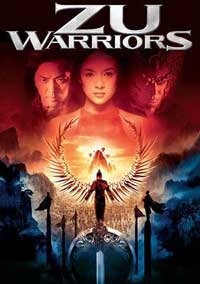 The cost of computer generated FX had dropped considerably so the animation wouldn't be quite as laughable in the sequel. Neither would it look the least bit real. The cost of computer generated FX had dropped considerably so the animation wouldn't be quite as laughable in the sequel. Neither would it look the least bit real.
A design for the film might have been worked up that blended live actors with animation effectively, if the designers had been clear-sighted enough to come up with something completely different from Tsui Hark's personal designs.
A handful of films like Avalon (2001), Sin City (2005), & Immortel (2004) have had sufficient genius to mix rotoscoping, live action, & CGI very smoothly & elegantly with real actors, blending the best of live action & animation. Legend of Zu isn't even close to harmonizing the cartoon to the living actors.
For example, the character of Red (Louis Koo) for example, who isn't red by the way, can instantanteously grow wings of metal knives & fight with his wings. When the actor hunches his back, the cartoon wings appear, & do their fantastic damage.
If you're stoned, or if you're six years old, it might look convincing. But even before you look at it on dvd in slow motion, it's so damned phony it ain't even funny.
An array of childishly absurd magical weapons are used by actors who weren't actually holding the impossible weapons when they went through their moves in front of a green-screen or while swinging on wires. So when the spinning Moon Orb knife or the idiotic miles-long sword are later superimposed on the characters, they just never look at all like they're using them.
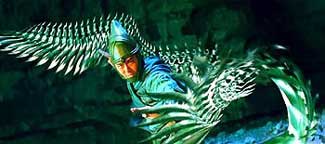 The actors by & large do not convince as martial artists. Quick editing & cartoon FX supplant physical skill or choreography. The actors by & large do not convince as martial artists. Quick editing & cartoon FX supplant physical skill or choreography.
And since Legend of Zu is strictly about the cartoon bits, & the characters don't matter & aren't well developed, the actors who might've done better in a different film are for the most part completely lost amidst the mediocre FX.
Imagine the horror of Mirimax investors when the product was delivered & it was this massively stupid. Even the visuals sucked, but the visuals were the "best" part. There's no acting to speak of & the story makes absolutely no sense & the cartoony bits don't match up with the live actors. What to do? Mirimax bit the bullet & took it as a total loss. They certainly weren't going to waste even more money promoting a turkey this laughable.
Eventually a different company would release it direct-to-video like it was no different from a cheap sasquatch movie. So while a decade earlier Hark's crap provided a commercial boon for the Hong Kong industry, in the new millenium he just about doomed the west's willingness to ever again trust a Chinese director to deliver a film that was even adequate, & even in Hong Kong it was a box office dud.
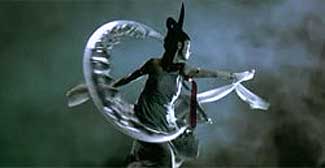 If you make the heroic effort to follow what Tsui Hark mistook for storytelling, you'll find instead a lot of Dungeons & Dragons type rules & regulations that might've been adapted to a video game, but you won't find a real story.
If you make the heroic effort to follow what Tsui Hark mistook for storytelling, you'll find instead a lot of Dungeons & Dragons type rules & regulations that might've been adapted to a video game, but you won't find a real story.
The one actor held over form the previous Zu film is the generally likeable Sammo Hung who reprises the role of Longbrows (or Whitebrows). His purpose is to sit on a dais & explain what's going on from time to time, lecutring on the rules of the role playing game or video game so to speak.
As in the original Zu film there are no villains of interest. The original villain was either a rock or an upended sea cucumber. This time the villain consists of small flying skulls that fly about in formation so as to look like one giant skull, then reduced to a drop of blood that becomes a devouring cavern. No personality, ipso facto, no villain.
The villain is a force, not a character, & even its name, Insomnia, is a snoozer. How Tsui Hark came to the conclusion that heroes don't need interesting villains to oppose I'll never grasp.
Though the FX are childish from concept to execution, some of them make good still photographs, touched up in the computer to look cute or occasionally convincing as they never could be when in motion. I really liked some of the stills which is why I decided just maybe Legend of Zu wouldn't be as bad as the previous film & maybe worth watching. Was I ever fooled.
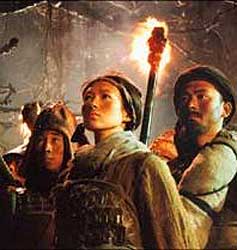 The character designs are elaborate, as they would have to be in a video game. Cecilia Cheung plays Dawn, a role roughly equivalent to Brigitte Lin's Countess in the original film.
The character designs are elaborate, as they would have to be in a video game. Cecilia Cheung plays Dawn, a role roughly equivalent to Brigitte Lin's Countess in the original film.
Dawn's weapon is the big moon-orb thingy which in the still is very pretty with Dawn posing like a goddess inside the circular weapon. On the screen that image lasts a half-second & everything before & after is dumb looking.
The main chracters are "fairies" or godlings hundreds or thousands of years old. These include King Sky (Ekin Cheng) who is the character that passes as the hero & obtains Dawn's moon orb thingy. "Joy" (Zhang Ziyi) is a general's daughter & the most "realistic" appearing character & a good enough actor to be convincing as a woman warrior. But she's barely included in any scenes & never has much to do.
"Hollow" incarnated as "Ying" (Jacky Wu) is a bald monk who has to regain his memory & master the miles-long cartoon sword. All such characters are manipulated into the cartoon environment to battle Generic Evil. Everyone is drop-dead gorgeous, but nothing else positive can be said about any of them.
The film introduces lots of ideas for the role playing game with lots of rules & powers apportioned to different players. It might be fun to play the game, but to passively watch is like watching some nose-picking kids playing the card game Magic. Even as a series of disconnected surrealist images this gets duller by the minute as the film descends into increasingly chaotic goofiness.
One of the most enthusiastic reviews I read of this awful film praised it to high heaven but admitted "I had no idea what was going on."
And there you go, the secret of Tsui Hark's continued capacity to get films bankrolled. Some fans don't care whether or not it makes a lick of sense, as some viewers approach films in the same way that Neanderthal man gazed into a burning fire pit. Ooo, pretty colors!
But as boxoffice dud on all continents, Hark may finally have plumbed "a depth of stupid" that even die-hard fans wouldn't willingly partake. At the 21st Hong Kong Film Awards, Legend of Zu got a number of nominations for action design, costuming, editing, sound FX, visual FX, action choreography, & editing. It won none of them, not even a token win out of pity. And the important nominations (for acting, writing, or direction) were entirely withheld.
copyright © by Paghat the Ratgirl
|
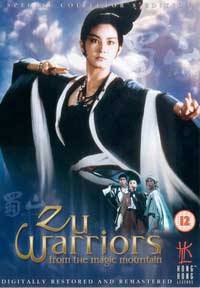

 While the primitive FX have been compared to Tron & Star Wars, a better comparison would be Saturday morning Power Rangers. The bad animation makes it a bad cartoon, but aren't the reason the film fails. Even if it had been a better drawn cartoon it could never have been a good story.
While the primitive FX have been compared to Tron & Star Wars, a better comparison would be Saturday morning Power Rangers. The bad animation makes it a bad cartoon, but aren't the reason the film fails. Even if it had been a better drawn cartoon it could never have been a good story.

 Floating on a cloud is a temple-fort ruled by martial fairy-maidens, their fearless leader called only Countess, played by Brigitte Lin. When the good knight-scholar becomes fouled by evil he cannot control himself from menacing the fairy maidens & what time is it kids? Flying kung fu fairy time!
Floating on a cloud is a temple-fort ruled by martial fairy-maidens, their fearless leader called only Countess, played by Brigitte Lin. When the good knight-scholar becomes fouled by evil he cannot control himself from menacing the fairy maidens & what time is it kids? Flying kung fu fairy time!
 The cost of computer generated FX had dropped considerably so the animation wouldn't be quite as laughable in the sequel. Neither would it look the least bit real.
The cost of computer generated FX had dropped considerably so the animation wouldn't be quite as laughable in the sequel. Neither would it look the least bit real. The actors by & large do not convince as martial artists. Quick editing & cartoon FX supplant physical skill or choreography.
The actors by & large do not convince as martial artists. Quick editing & cartoon FX supplant physical skill or choreography.
